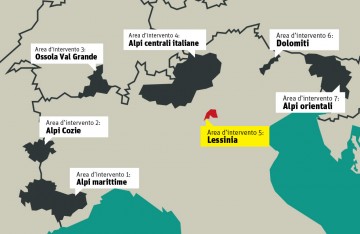Name: Lessinia
Surface (ha): 40,040.000
Main land uses and ownership status of the project area:
About 13% of the territory is covered by alpine meadows, 51% by forests. To the south the natural vegetation is dominated by riparian forests along the rivers, and large areas of cultivated fields and vineyards are also present. About 25% of the core area is occupied by the Natural Park of Lessinia, a destination for naturalistic and cultural tourism, both in summer and in winter. Also ski resorts are present. High pastures are used during the summer for grazing and extensive farming, mainly cattle, while in the south part of the core area, agricultural (mainly of grapevine and fruits) and forestry
activities are prevalent. The property is mostly private and only 5% of the core area is state-owned.
Natural features of the area:
The area is occupied by a prealpine plateau sloping to the south, connected to the
Padan plain by narrow longitudinal valleys of fluvial origin similar to canyons (locally called “vaj”). From the geological point of view the area is mainly composed of sedimentary rocks with a limited presence of volcanic nuclei in the eastern sector. The whole area, emerged from the sea about 40 million years ago, has undergone over the erosive action of water, ice (in the far north) and wind, which have shaped, carved and perforated the limestone cliffs producing large karsts phenomena. The abundance of marine fossils testify the rich geological history of the area: the findings
of Bolca are famous throughout the world and make Lessinia a very special area.
The vastness of the territory still determines the presence of a wide variety of environments. Among the most beautiful and best preserved forest of the plateau, a special mention deserve the Folignani Forest in the heart of the park, the Giazza Forests, the woods of the high Vajo of Squaranto and of the high Vajo the Falcons. At the highest altitudes of the eastern side vegetation of twisted shrubs (Pinus mugo) is
present. In the south side of territory the vegetation cover is dominated by orno-ostryetum and aceri-fraxinetum association, and riparian forests along the rivers. At more low altitude in hillsides vast areas of cultivated fields and vineyards are present, interspersed with forests of chestnut or, more frequently, ostrya-quercetum forest. Large areas of Lessinia are characterized by flora and fauna of significant interest. There are a large number of rare, endemic and endangered floristic entities.
As for the fauna, the group of invertebrates is of particular interest, with numerous endemic troglobic and arthropod species of exceptional importance, such as Italaphaenops dimaioi, the world’s largest cave beetle.
In the hills and in the valleys of the plateau the most typical alpine species belonging to
mammals and birds are well represented. The environment of Lessinia is particularly favorable for the presence of ungulates, especially roe deer, red deer and at higher altitudes chamois. Since the last 10 years wildboar is expanding at alarming
level. The high density and the variety of ungulates, and generally environmental capacity, have facilitated the natural return of species for long disappeared in the region, such as bears (Ursus arctos) and wolves (Canis lupus), further increasing the degree of biodiversity.
The wolf
In early 2012 an event of exceptional naturalistic interest occurred in Lessinia: the natural dispersal, meeting and stabilization of two different wolves, a male named Slavc of the Dinaric population in dispersion from Slovenia, radiocollared in the framework of the EU Life project SloWolf, and a second individual female of the Italian wolf population. The presence of these two wolves in Lessinia is of extraordinary scientific interest being the first case of a wolf pair made of the two Dinaric and Italian populations, since the species became extinct in the Alps. The wolf was present in the Alps until the
end of the 19th century and, more sporadically, until the first decades of the twentieth century. In Veneto the latest wolf reports date back to 1931 for the area of Belluno (Fossa, 1988), while in Lessinia the species seems to have died out in the first half of 1800 (Garbini, 1898), with possible isolated appearances in 1880 (Benetti, 2003). The wolf in Lessinia is historically linked to the socio-cultural traditions of the Cimbrian population, as attested by toponyms, fables, legends, proverbs and sayings
having this mythical animal as protagonist. The presence of wolf in Lessinia further enhances the biodiversity of the area, confirming its role as privileged reservoir of valuable natural resources


